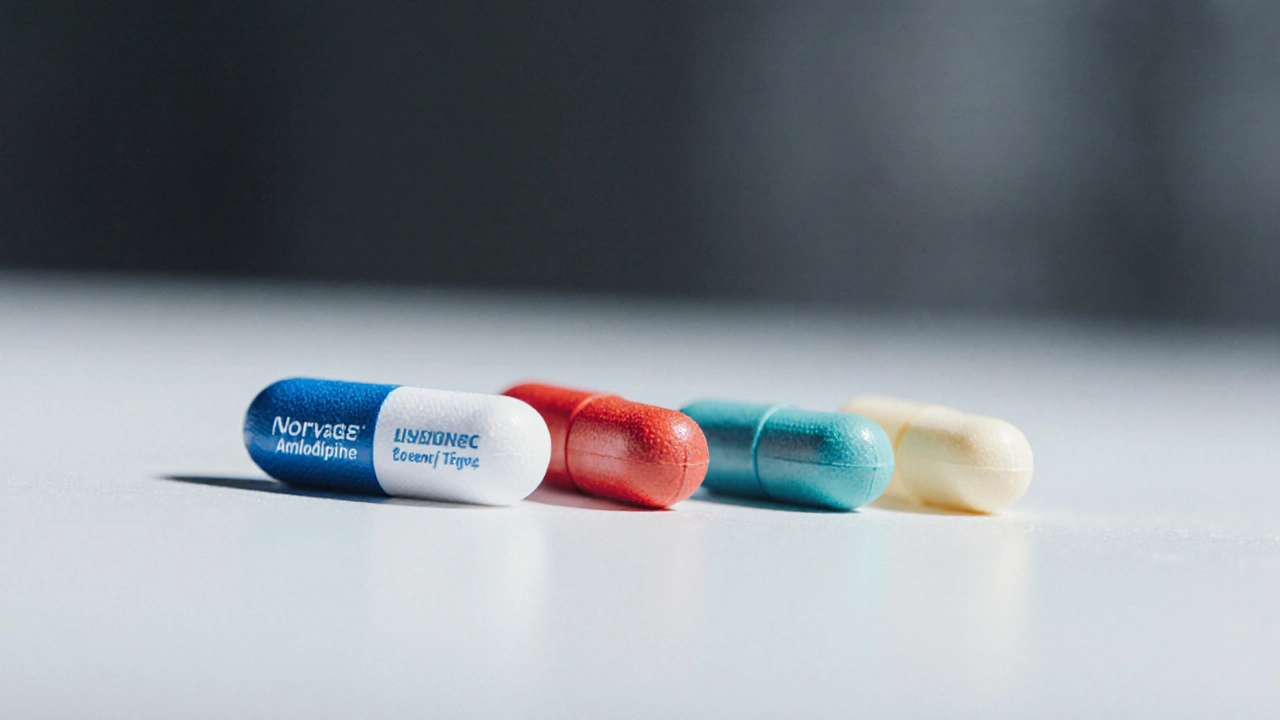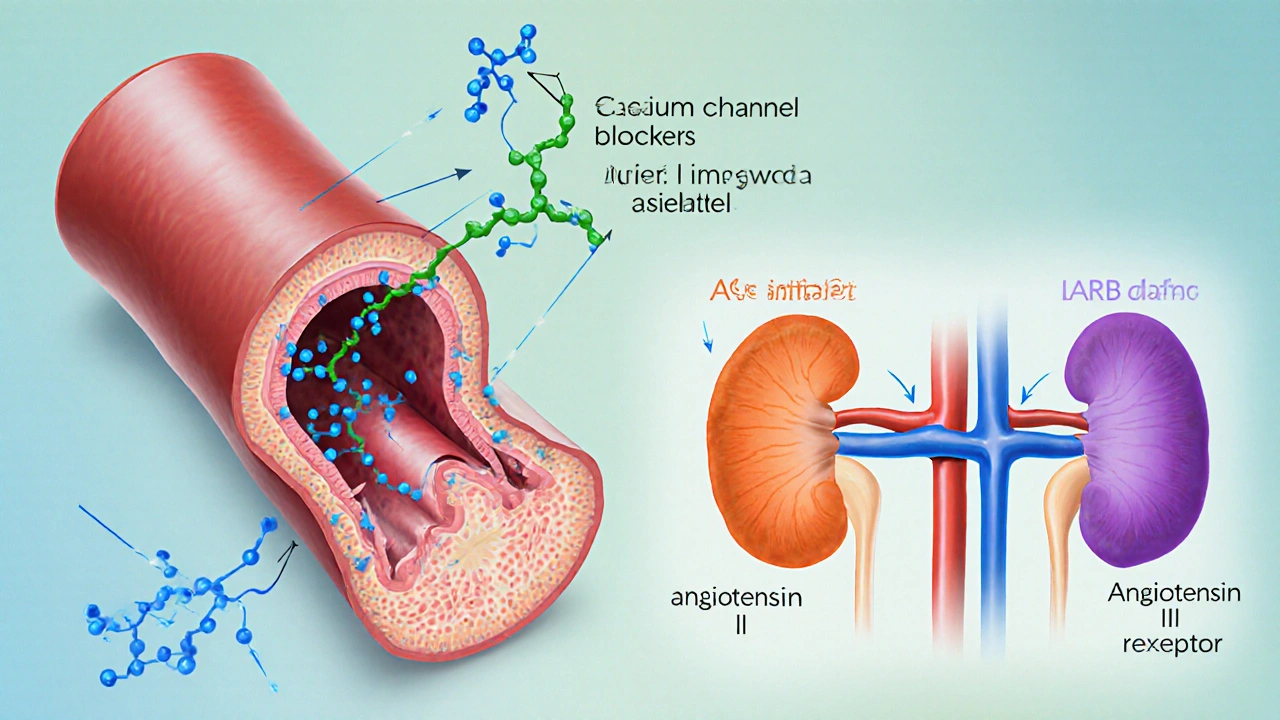Norvasc (Amlodipine) vs. Top Blood Pressure Alternatives - 2025 Comparison

Key Takeaways
- Norvasc (amlodipine) is a calcium‑channel blocker mainly used for hypertension and angina.
- ACE inhibitors (e.g., lisinopril) and ARBs (e.g., losartan, valsartan) are the most common first‑line alternatives.
- Thiazide diuretics such as hydrochlorothiazide work by reducing fluid volume and are often combined with other classes.
- Side‑effect profiles differ: amlodipine can cause swelling, while ACE inhibitors may trigger cough.
- Cost and drug‑interaction considerations can tip the balance toward a specific alternative for any individual.
What Is Norvasc (Amlodipine)?
Norvasc is a brand‑name formulation of amlodipine, a long‑acting dihydropyridine calcium‑channel blocker approved for treating high blood pressure and chronic stable angina. In Australia, the standard tablet contains 5mg or 10mg of the active ingredient, taken once daily. The drug relaxes the smooth muscle in arterial walls, which lowers peripheral resistance and eases the heart’s workload.
How Does Amlodipine Work?
Amlodipine blocks L‑type calcium channels in vascular smooth muscle. By preventing calcium influx, the vessels stay dilated, leading to a steady drop in systolic and diastolic pressure. Because the effect is gradual, patients rarely experience sudden hypotensive episodes.
Typical therapeutic outcomes include a 10‑15mmHg reduction in systolic pressure after 2‑4 weeks of consistent use. The drug’s half‑life of about 30‑50 hours allows for once‑daily dosing, which improves adherence compared with shorter‑acting agents.

Top Alternatives to Norvasc
When doctors evaluate alternatives, they look at drug class, efficacy, side‑effects, cost, and any comorbid conditions. Below are the five most frequently considered options.
Lisinopril is an ACE (angiotensin‑converting enzyme) inhibitor that lowers blood pressure by preventing the conversion of angiotensin I to the vasoconstrictor angiotensin II. It’s especially useful for patients with diabetic kidney disease because it slows micro‑albuminuria progression.
Losartan belongs to the ARB (angiotensin‑II receptor blocker) family, blocking the same end‑point as ACE inhibitors but without increasing bradykinin levels, which reduces the risk of cough.
Hydrochlorothiazide is a thiazide diuretic that promotes sodium and water excretion, decreasing blood volume and peripheral resistance. It’s often paired with a calcium‑channel blocker for synergistic effect.
Valsartan is another ARB, chemically similar to losartan but with a slightly longer half‑life, allowing for consistent 24‑hour blood pressure control.
Generic Amlodipine offers the same active ingredient as Norvasc at a lower price point, but without the brand‑specific extended‑release matrix that some patients find gentler on the stomach.
Head‑to‑Head Comparison Table
| Drug | Class | Typical Daily Dose | Primary Indication | Common Side Effects | Average PBS Cost (AU$) | Notable Contra‑indications |
|---|---|---|---|---|---|---|
| Norvasc (amlodipine) | Calcium‑channel blocker | 5mg - 10mg | Hypertension, chronic angina | Peripheral edema, flushing, headache | ~AU$30 (brand) | Severe hypotension, cardiogenic shock |
| Lisinopril | ACE inhibitor | 10mg - 40mg | Hypertension, heart failure, post‑MI | Cough, hyperkalemia, dizziness | ~AU$12 (generic) | History of angio‑edema, pregnancy |
| Losartan | ARB | 50mg - 100mg | Hypertension, diabetic nephropathy | Fatigue, dizziness, hyperkalemia | ~AU$15 (generic) | Pregnancy, bilateral renal artery stenosis |
| Hydrochlorothiazide | Thiazide diuretic | 12.5mg - 25mg | Hypertension, edema | Increased urination, electrolyte imbalance, gout flare | ~AU$8 (generic) | Severe kidney impairment, hyperuricemia |
| Valsartan | ARB | 80mg - 160mg | Hypertension, heart failure | Dizziness, headache, hyperkalemia | ~AU$14 (generic) | Pregnancy, severe hepatic impairment |
| Generic Amlodipine | Calcium‑channel blocker | 5mg - 10mg | Hypertension, angina | Same as Norvasc (edema, flushing) | ~AU$5 | Same as Norvasc |

Choosing the Right Medication for You
There’s no one‑size‑fits‑all answer. A good starting point is to match the drug class with your health profile.
- Kidney concerns: ACE inhibitors or ARBs protect renal function, making them preferable if you have early chronic kidney disease.
- Persistent cough: Switch from an ACE inhibitor to an ARB (losartan or valsartan) to avoid the bradykinin‑related cough.
- Fluid retention: If swelling is a problem on amlodipine, adding a thiazide diuretic or switching to an ACE/ARB can balance the fluid shift.
- Cost sensitivity: Generic amlodipine or hydrochlorothiazide provide the biggest savings under the PBS scheme.
- Pregnancy: None of the above are first‑line during pregnancy; methyldopa or labetalol are usually recommended instead.
Always discuss these factors with your GP or pharmacist. They can review your lab results, current meds, and lifestyle to tailor the prescription.
Frequently Asked Questions
Can I switch from Norvasc to a generic version without my doctor’s approval?
You should always get a clinician’s go‑ahead. While the active ingredient is identical, the brand’s formulation may have a slightly different release profile, and a sudden switch could affect blood‑pressure stability.
What makes ACE inhibitors different from ARBs?
ACE inhibitors block the conversion of angiotensin I to II, while ARBs block the receptor that angiotensin II binds to. The end result-lower blood pressure-is similar, but ARBs tend to cause fewer cough-related side effects.
Is it safe to take a calcium‑channel blocker and a thiazide together?
Yes, many clinicians prescribe that combo because the mechanisms complement each other-one dilates vessels, the other reduces fluid volume. Monitoring electrolytes is advised.
Why does amlodipine cause ankle swelling?
The drug relaxes peripheral arterioles, which can raise hydrostatic pressure in capillaries, leading to fluid leaking into surrounding tissue-most noticeable around the ankles.
Do any of these alternatives interact with common over‑the‑counter meds?
ACE inhibitors and ARBs can increase potassium when taken with potassium‑sparing diuretics or salt substitutes. NSAIDs may blunt the blood‑pressure‑lowering effect of all these agents.
Mary Akerstrom
October 12, 2025 AT 04:07The edema side effect of amlodipine often trips people up
Delilah Allen
October 14, 2025 AT 22:07Considering how the vascular system responds, it's fascinating that a single calcium channel blocker can shift hemodynamics so dramatically, yet many patients remain unaware of the subtle fluid shifts, leading to that dreaded ankle puffiness, which in turn can affect mobility and confidence; this cascade underscores the importance of monitoring, adjusting dosage, and communicating side effects early, before they become entrenched
Nancy Lee Bush
October 17, 2025 AT 16:07It's encouraging to see that generic amlodipine offers a cost‑effective alternative, especially for those juggling multiple prescriptions 😊 the lower price point doesn't compromise efficacy, and many patients report similar blood‑pressure control without the brand's extended‑release nuances
Dan Worona
October 20, 2025 AT 10:07While the table lists prices, it's worth remembering that pharmaceutical lobbying often skews PBS listings, pushing newer, pricier drugs into the spotlight while older, proven options get buried
Mita Son
October 23, 2025 AT 04:07Yo, the thiazide combo is totallly a game‑changer – it flushes out that extra fluid, but watch out for that electrolyte rollercoaster, especially potassium spikes!!
ariel javier
October 25, 2025 AT 22:07The article glosses over the pivotal role of renal function monitoring when initiating ACE inhibitors; a mere mention of cough is insufficient, as overlooking hyperkalemia can precipitate life‑threatening arrhythmias, which is an unacceptable omission in any serious pharmacological review
Bryan L
October 28, 2025 AT 16:07From a cultural standpoint, many patients in diverse communities prefer once‑daily dosing to fit busy lifestyles, making amlodipine’s long half‑life a real advantage 😊
joseph rozwood
October 31, 2025 AT 10:07Honestly, the “top alternatives” list feels like a generic copy‑paste from a textbook; where's the nuanced discussion of patient‑specific comorbidities, like how ARBs might be preferable in African‑American populations with higher salt sensitivity? Also, the cost figures ignore bulk‑discounts, so the analysis is half‑baked at best
Richard Walker
November 3, 2025 AT 04:07Balancing efficacy and side‑effects is key; some folks tolerate the mild headache from amlodipine just fine, while others find the peripheral edema intolerable and switch to an ARB without a second thought
Julien Martin
November 5, 2025 AT 22:07Pharmacokinetic profiling indicates that amlodipine’s 30‑50‑hour half‑life permits stable plasma concentrations, reducing peak‑trough variability which is particularly beneficial for patients with adherence challenges
Jason Oeltjen
November 8, 2025 AT 16:07We must hold prescribers accountable for disclosing all potential adverse effects to patients
Mark Vondrasek
November 8, 2025 AT 16:07When you stare at the comparison table, the first thing that hits you is how the numbers look almost too tidy.
It’s as if someone polished the data with a fresh coat of corporate glaze, hoping you won’t notice the hidden costs.
The cost column, for instance, excludes the sneaky dispensing fees that many pharmacies slap on top of the PBS price.
Meanwhile, the side‑effect list reads like a marketing brochure, conveniently omitting the rare but serious complications that can land patients in the ER.
You have to wonder why the cough associated with ACE inhibitors gets a single line while the edema from amlodipine gets a full paragraph.
Perhaps it’s because the pharmaceutical lobby funds the writers of these guides, ensuring their favorite drugs get a glowing mention.
The mention of “generic amlodipine” as a cheaper alternative seems sincere, yet the bioavailability differences are brushed aside as negligible.
In reality, that slight formulation tweak can cause a measurable dip in blood‑pressure control for a subset of patients.
Then there’s the glaring absence of any discussion about drug‑interaction alerts for NSAIDs, which can blunt the efficacy of virtually every antihypertensive on the list.
It’s a classic case of selective transparency, where the information you need to make an informed decision is hidden behind a wall of jargon.
The table also fails to address the ethnic variations in drug response, a fact that’s especially pertinent in multicultural societies.
For example, studies have shown that Black patients often achieve better outcomes with calcium‑channel blockers than with ACE inhibitors.
Yet the guide lumps everyone together, as if biology were a one‑size‑fits‑all model.
All these omissions add up to a narrative that steers you toward the brand name, subtly nudging the reader to think that the extra cost is justified.
So before you swallow the recommendations at face value, dig deeper, ask your pharmacist, and remember that the truth is often buried beneath the glossy presentation.
Joshua Agabu
November 11, 2025 AT 10:07Keeping an eye on electrolytes is smart when you combine a diuretic with a calcium blocker
Lolita Rosa
November 14, 2025 AT 04:07Nothing says “I care about my health” like picking the cheapest pill and ignoring the real side‑effects that affect our great nation’s workforce!
Matthew Platts
November 16, 2025 AT 22:07Honestly, if you stick to the basics and follow up with your doctor, you’ll likely find a regimen that works without breaking the bank
Matthew Bates
November 19, 2025 AT 16:07From a pharmacological perspective, the distinction between ACE inhibitors and ARBs lies in their mechanistic interaction with the renin‑angiotensin system; ACE inhibitors inhibit the conversion of angiotensin I to II, whereas ARBs block the binding of angiotensin II to its receptor, thereby yielding comparable antihypertensive effects with differing side‑effect profiles
Kasey Mynatt
November 22, 2025 AT 10:07Great breakdown! That clear explanation helps anyone trying to navigate the maze of blood‑pressure meds, especially when you’re juggling side‑effects and costs